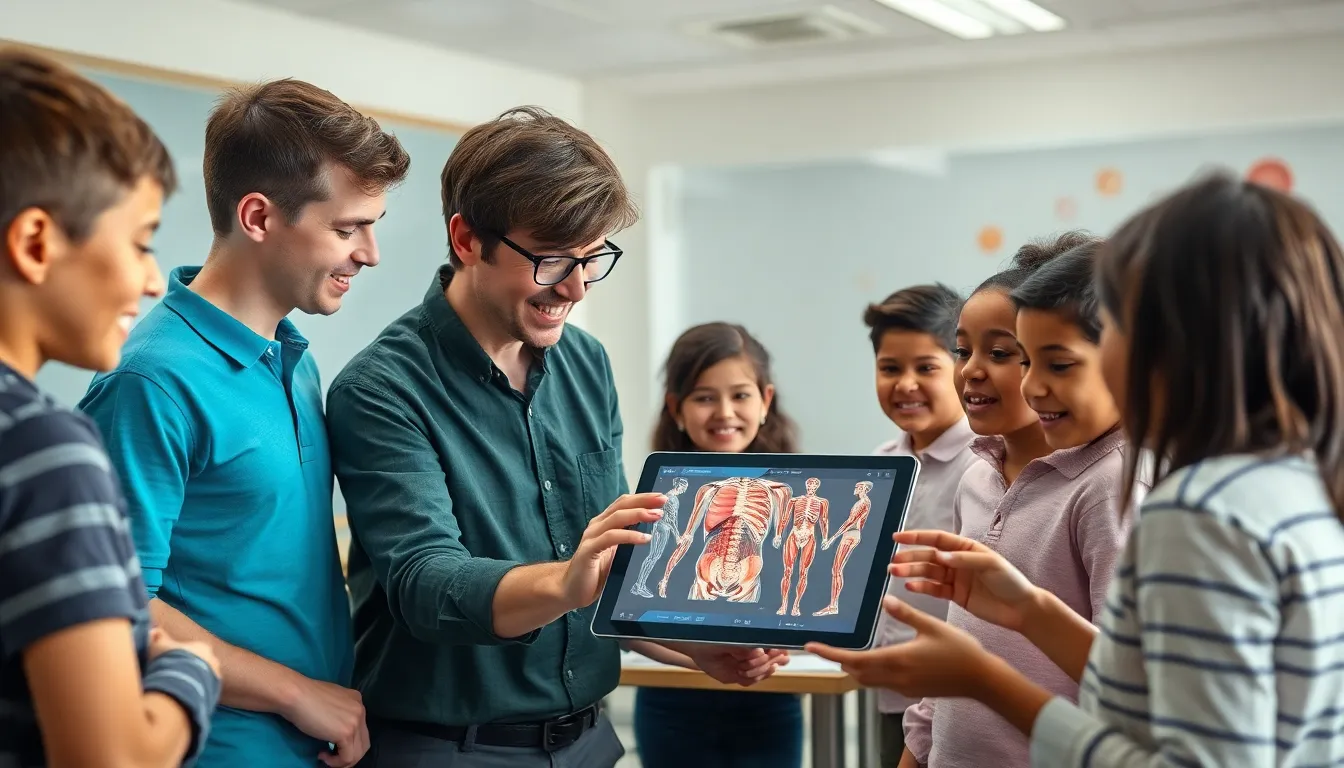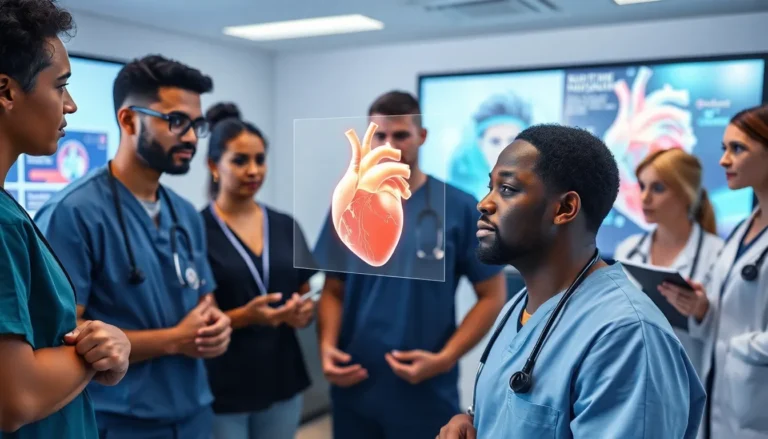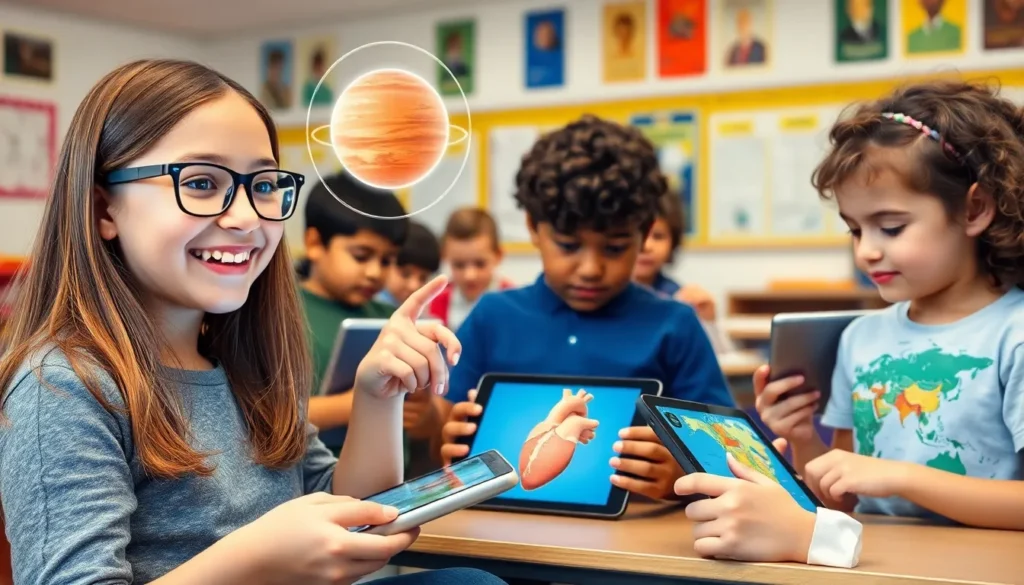Table of Contents
ToggleImagine a classroom where history comes alive, math problems leap off the page, and science experiments happen right in your living room. Sounds like magic, right? Well, it’s not—it’s augmented reality (AR) and it’s transforming education as we know it. With AR apps, learning becomes an interactive adventure that engages students like never before.
Overview of Augmented Reality in Education
Augmented reality transforms learning experiences in education. It enhances engagement by layering digital information over real-world environments. Students interact with subjects like anatomy, geography, and languages in ways that textbooks alone cannot provide.
AR apps cater to various learning styles, making them adaptable for different educational needs. Visual learners benefit from 3D models that illustrate concepts vividly, while auditory learners find interactive simulations engaging. Kinesthetic learners thrive in AR environments, where they can manipulate elements and explore dynamically.
Research shows that incorporating AR into lessons increases retention rates. One study highlighted a 30% improvement in knowledge recall among students using AR tools compared to traditional methods. Teachers report higher student motivation when using AR applications.
Educational institutions embrace AR technology, investing in tools that support innovative teaching methods. For example, platforms like Google Expeditions allow students to take virtual field trips, exploring distant landmarks or historical sites without leaving the classroom. Additionally, apps like Merge Cubes offer immersive experiences in subjects like mathematics and science, providing interactive learning opportunities.
Challenges exist in implementing AR in education, such as technology access and teacher training. Nonetheless, ongoing advancements in mobile devices and software increase accessibility for both educators and students. As AR continues to evolve, so too does its potential to reshape educational landscapes, promising a future where immersive learning is integral to student development.
Benefits of Augmented Reality Apps for Education

Augmented reality (AR) apps offer significant advantages in educational settings. These benefits enhance the overall learning experience for students.
Enhanced Engagement and Motivation
AR apps capture student attention effectively. They transform mundane lessons into interactive experiences. Students become active participants rather than passive learners. As a result, motivation levels often rise, leading to increased participation. Gamified elements and dynamic visuals intrigue students, stimulating curiosity. Research demonstrates that lessons featuring AR can lead to a 30% improvement in knowledge retention. Teachers observe higher levels of enthusiasm, creating a more vibrant classroom environment. Engaging content encourages students to explore topics deeper and fosters a love for learning.
Improved Learning Outcomes
Learning outcomes improve notably when using AR applications. Students grasp complex concepts more easily with visual aids and interactive features. For instance, subjects like anatomy and geography become tangible, enhancing understanding. Diverse learning styles receive support, benefiting visual, auditory, and kinesthetic learners alike. The combination of real-world interactions and digital information promotes critical thinking skills. Evidence shows improved test scores and better knowledge recall among students utilizing AR in the classroom. Teachers can personalize lessons, catering to individual student needs more effectively, further supporting academic success.
Popular Augmented Reality Apps for Education
Several augmented reality apps significantly enhance educational experiences. Each app offers unique features that cater to diverse learning needs.
App 1: Key Features and Benefits
Google Expeditions immerses students in virtual field trips. Users can explore historical sites, outer space, and ocean depths. Teachers guide students through lessons while leveraging 360-degree imagery for a comprehensive understanding of various subjects. This app promotes collaboration, as students work together in paired ventures to explore environments. Enhanced engagement is reported, with many educators seeing a marked increase in interest during lessons.
App 2: Key Features and Benefits
Merge Cube allows students to interact with 3D objects using their devices. Users can explore anatomy, solar systems, and historical artifacts in a hands-on manner. Educational content is made more tangible with detailed visuals that enhance comprehension. Additionally, the app encourages critical thinking and problem-solving through interactive challenges. Many teachers note improved performance in assessments following the integration of Merge Cube into the curriculum.
App 3: Key Features and Benefits
Zapper creates interactive experiences through QR codes and AR features. Educators can design customized content that links to assignments and multimedia resources. This flexibility allows for varied instructional strategies, catering to visual and kinesthetic learners. Enhanced student motivation stems from the gamified elements incorporated into lessons. Feedback shows that students are more likely to engage with learning materials when using Zapper, resulting in better knowledge retention and understanding.
Challenges in Implementing Augmented Reality Apps
Implementing augmented reality (AR) apps in education presents several challenges.
Technical Limitations
Technical limitations frequently hinder effective implementation of AR. Many AR applications require advanced hardware capabilities, which not all institutions possess. Certain devices may not support specific apps, leading to inconsistent user experiences. Moreover, connectivity issues can disrupt the interactive nature of AR, reducing engagement levels. Additionally, battery life concerns may arise during extended use, affecting usability in classrooms. These technical challenges necessitate careful planning and resource allocation to maximize AR’s potential in educational settings.
Teacher Training and Support
Teacher training and support play crucial roles in successful AR integration. Many educators lack the necessary skills to effectively utilize AR applications. Providing professional development opportunities is essential for helping teachers become proficient in using these technologies. Access to ongoing support ensures educators can troubleshoot and implement AR tools effectively in their lessons. Schools must also foster a culture of collaboration, allowing teachers to share successes and challenges in using AR. This collaborative environment enhances innovation and effectiveness in adopting AR technologies in education.
Future of Augmented Reality in Education
Augmented reality’s future in education appears bright as technology continues to evolve. Institutions are increasingly integrating immersive experiences that promise to enhance learning outcomes. With improvements in mobile devices, AR applications will become more accessible and user-friendly, expanding their reach within classrooms.
The potential for personalized learning remains significant. Customizable AR content allows teachers to tailor lessons that cater to diverse learning styles, addressing the needs of visual, auditory, and kinesthetic learners. Innovations in AR features will likely enhance students’ understanding of complex subjects, fostering critical thinking skills and improved retention rates.
Research is pivotal in demonstrating AR’s effectiveness. Studies indicate AR-assisted learning can increase knowledge recall by 30% compared to traditional methods, reinforcing the importance of adopting these technologies. As educators witness these positive trends, increased investment in AR resources will likely follow.
Collaboration between technology developers and educators will shape the next generation of AR tools. Programs such as Google Expeditions and Merge Cubes highlight successful partnerships, but ongoing feedback and support are essential for continuous improvement. Through professional development, educators will gain the skills needed to maximize AR’s potential in their teaching practices.
Challenges remain in the implementation of AR. Addressing technical limitations, such as hardware requirements and connectivity issues, is crucial for ensuring effective use. Battery life will also need consideration, especially during extended classroom sessions. With thoughtful planning and investment in training, educational institutions can overcome these obstacles to facilitate an immersive learning experience.
The promise of AR apps in education extends beyond simple engagement. These tools will transform traditional subjects into interactive explorations, making learning an adventure rather than a chore.
Augmented reality apps are reshaping the educational landscape by making learning more interactive and engaging. As students explore subjects through immersive experiences they develop a deeper understanding and retention of knowledge. The adaptability of AR technology caters to various learning styles ensuring that all students can benefit from its applications.
While challenges exist in terms of technology access and teacher training the potential of AR in education is undeniable. As institutions invest in these tools the future looks bright for immersive learning experiences. By fostering collaboration between educators and technology developers the classroom can evolve into a dynamic environment where learning becomes an exciting adventure.







